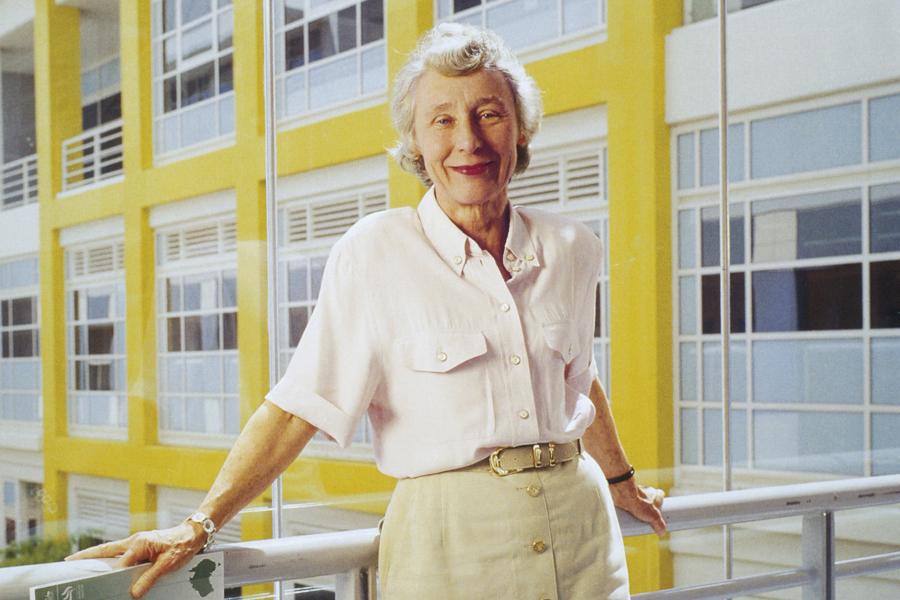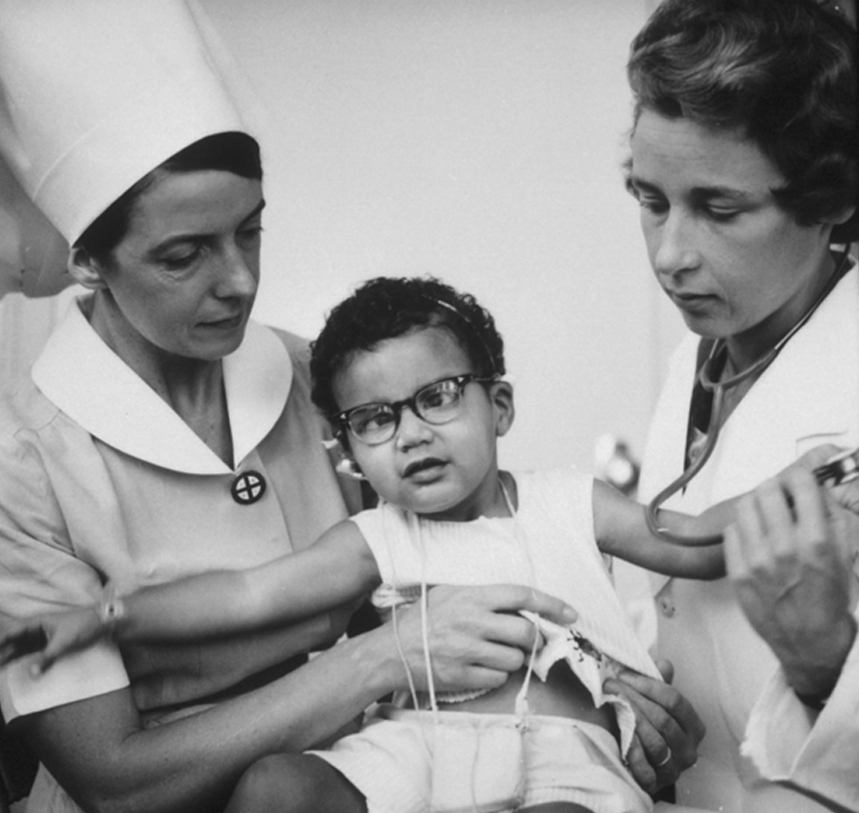A remarkable paediatrician who pioneered research into vaccines and vaccine-preventable diseases in Australia
Margaret Burgess (nee Menser, 1937–) was born in Sydney, and it is Sydney alone that can claim credit for her education and the achievements of a career spanning, unusually, laboratory, clinical and population-based research. Her contributions to medicine are of international importance to our understanding of congenital rubella and its prevention, and to clinical and public health aspects of the control of vaccine-preventable disease more generally. With more than 250 published articles and 20 book chapters, and an Order of Australia for services to public health, Margaret can rightly be considered a pre-eminent paediatric researcher of her generation.
Margaret’s intellectual and personal qualities first became evident as captain of Fort Street Girls High School in 1954. She went on to study medicine at the University of Sydney, where she was active in the University Women’s Union. On graduating in 1961, she won the Dagmar Berne Prize for first place among women candidates and was first in the year in surgery. The link with Dagmar Berne, who was the first woman to enrol in medicine in Australia in 1885, but who needed to transfer to London to evade obstruction to her graduation in Sydney, is apposite. In 1964, Margaret became the first woman appointed as a medical or surgical registrar at the Royal Prince Alfred Hospital (RPAH) since the end of World War II, and had to deal with a number of obstacles on her path — but more of this later.
Margaret Burgess, Director of the National Centre for Immunisation Research and Surveillance of Vaccine-Preventable Diseases, 2003.
Her inclination towards paediatrics and child health began when she was a medical student. This was prompted first by the tragic but expected death of her sister Lynette, after surgery for cyanotic congenital heart disease, and second by the inspirational teaching of Australia’s first Professor of Paediatrics, Sir Lorimer Dods. He encouraged her to stay at RPAH to study for membership of the Royal Australasian College of Physicians (MRACP), as there was no separate paediatric examination, and Margaret qualified as MRACP in 1965. She immediately began research work with Lorimer Dods at the Children’s Medical Research Foundation (CMRF) and began a lifelong association with the Royal Alexandra Hospital for Children.
The year 1965 was a propitious one to commence a paediatric research career. There was a rubella outbreak in Sydney, which followed epidemics in the United States. The large number of newborns in the US with severe sequelae, such as blindness, deafness and congenital heart disease, together with the isolation of the rubella virus in 1962, galvanised efforts to develop a vaccine to prevent rubella infection. Sydney already had a strong association with rubella. In 1941 ophthalmologist (later Sir) Norman Gregg had noted that mothers of infants with cataract frequently gave a history consistent with rubella (then believed to be no more than a mild illness with rash) during their pregnancy. Thus, Margaret could draw on a cohort of congenital rubella survivors for study, starting with those from 1941.
Her first article on the late sequelae and associations of rubella appeared in The Lancet in 1966, and described “renal artery stenosis in the rubella syndrome”.1 After publishing seven additional articles in The Lancet, including landmarks such as the isolation of the rubella virus from the lens of a child with cataract,2 Margaret, with medical school friend Jill Forrest and husband John Burgess, reported the propensity of congenital rubella survivors to develop diabetes.3 This important article was published in 1971, the year she was awarded her Doctor of Medicine (MD) degree.
During this period of great research productivity, Margaret married endocrinologist John Austin Burgess in 1968, and had given birth to their two sons, Michael (1970) and David (1972). David was delivered at home after an unexpectedly rapid labour while his father was, by his own account, “still looking for the textbook”. Careers for married women, and certainly for those with children, were a novelty in the Australia of the 1960s. For Margaret, time out after the birth of her sons was limited to accumulated leave.
Margaret with a congenital rubella patient at the Royal Alexandra Hospital for Children, 1967.
In 1968, an opportunity arose — which combined Margaret’s awareness of the needs of deaf children through her congenital rubella work and of the needs of professional women — to advocate for a childcare centre at the University of Sydney. The Shepherd Centre for education of the deaf (named after orthopaedic surgeon Bruce Shepherd and his wife Annette who had two deaf children), was being planned, and there was room on the ground floor for a childcare centre. An appointment was arranged to the see the University Registrar, who listened to the four women in the delegation with studied disinterest before declaring “I see no more reason why the University should provide a childcare centre than a petrol station”. This kindled both anger and — in the tradition of Dagmar Berne — a steely determination to overcome the insolence of office. Margaret and her co-conspirators were put in touch with the wife of Vice-Chancellor (Sir) Bruce Williams (who had five daughters) and the childcare centre was born in 1970.
Later in the 1970s, while her children were still young, the next phase of Margaret’s career began — conducting clinical trials of rubella vaccine allied with epidemiological and public health aspects of vaccines and vaccination programs. Her work on the rubella vaccine expanded over the next 30 years to include vaccines against measles, mumps, pertussis, varicella, hepatitis B and rotavirus, to name only some. In 1978, Margaret published a trial of a new rubella vaccine in schoolgirls and seroprevalence studies in The Medical Journal of Australia, and in 1984, she reported the impact of rubella vaccine in Australia in The Lancet,4 all while working on a busy roster in clinical oncology. There were competing approaches to rubella vaccination at the time. Australia, like the United Kingdom, gave rubella vaccine only to girls in early high school whereas the United States gave rubella vaccine to young children. Later, it became apparent that both strategies in both sexes were needed to eliminate the indigenous transmission of rubella, thus minimising risks to the developing fetus.5
Eliminating measles — an even greater challenge than rubella — was tackled through the national Measles Control Campaign (MCC) of 1998, which provided combined measles, mumps and rubella (MMR) vaccine to all Australian primary school children.6 The MCC had been preceded in 1997 by the Immunise Australia Program or “Seven Point Plan”, which had as one of its seven points the establishment of a National Centre for Immunisation Research and Surveillance of Vaccine-Preventable Diseases (NCIRS). Margaret led the successful tender, becoming the founding Director of NCIRS in August 1997 and Professor of Paediatrics and Preventive Medicine at the University of Sydney in 1998. This late recognition reflects the slow ascension of women to higher academic appointments of the time — Margaret had attained the rank of Clinical Associate Professor only in 1992, despite academic achievements many years previously that today would justify full professorial appointment.
As a key component of the bid for the NCIRS, Margaret, in collaboration with Lyn Gilbert at the Institute of Clinical Pathology and Medical Research, proposed the now regular national serosurvey, which examines age-specific prevalence of protective levels of antibodies to vaccine-preventable diseases at a population level. The national serosurvey proved to be a critical component of the evaluation of the MCC, demonstrating its success in increasing population immunity.5 This evidence later underpinned the declaration of elimination of indigenous transmission of measles and rubella in Australia. Margaret’s tenure as Director of NCIRS from 1997 to 2003 coincided with an enormous expansion of immunisation programs in Australia, with national funding for the purchase of vaccines increasing more than tenfold. Margaret played a large role in paving the way for the addition of varicella vaccine (in 2005) and rotavirus vaccine (in 2007) to the National Immunisation Program.
Less well known is Margaret’s vision in drawing attention to the need for strengthened monitoring and reporting of vaccine safety in the 1990s,7 a time when this was not a popular cause. She emphasised the special importance of safety monitoring during national campaigns — groundwork that proved vital when Australia had challenges relating to the safety of vaccines against human papillomavirus in 2007 and influenza in 2010.
Despite (or perhaps aided by) her personal modesty, others have recognised the calibre of Margaret’s achievements. In Australia, she was awarded the Queen Elizabeth II Silver Jubilee Medal for services to the community in 1997 and the Howard Williams Medal of the Royal Australasian College of Physicians in 2006. Internationally, she was invited to join the Strategic Advisory Group of Experts (SAGE) of the World Health Organization’s Department of Vaccines and Biologicals in 2001, and was awarded an Order of Australia in 2003 for her services to public health in Australia and overseas, particularly through providing policy advice to government and research into vaccine-preventable diseases. In his foreword to the NCIRS biennial report in 2006, Sir Gustav Nossal commented that Margaret’s “legacy is evident underlying the productivity of NCIRS through its team spirit, flexibility of work practices and mutual supportiveness, which takes a long time to nurture”.
Perhaps the greatest testimony to Margaret’s personal and professional qualities is the universal regard she engendered in so many who were in positions elevated and humble, academic and at the coalface. Those treated to dinner at their Killara home remember with enormous affection the hospitality and unfailing courtesy of both Margaret and her late husband John, who sadly passed away in 2010. A giant photograph of Margaret and John adorned billboards outside the Chris O’Brien Lighthouse at RPAH during its construction. Margaret is actively engaged in the lives of her twin grand-daughters, Eleanor and Jacqueline, and although steadfastly maintaining she is retired, still reads The Lancet and New England Journal of Medicine every week. She leaves a lasting legacy to the fields of paediatrics, immunisation and public health. As a role model, to borrow the words of Kathryn North, a paediatrician who trained at the Royal Alexandra Hospital for Children and who is now Chair of the National Health and Medical Research Council Research Committee: “Margaret is a fabulous mentor — she leads by example, she listens, she cares. She has been an amazing role model for so many. I want to be just like her when I grow up”.

 more_vert
more_vert
